The idea of using artificial intelligence to streamline business isn’t new. For years, companies have relied on AI to improve workflows, reduce overhead, and make smarter decisions faster.
But things have changed — and quickly. The rise of generative AI tools like ChatGPT and Claude has brought AI into everyday business use, turning it from a back-end tool into a front-line force.
These platforms are changing how teams create, plan, and interact.
Let’s dive into the latest companies using AI stats that show how businesses worldwide are using AI right now, what’s driving the growth, and where things are headed next.
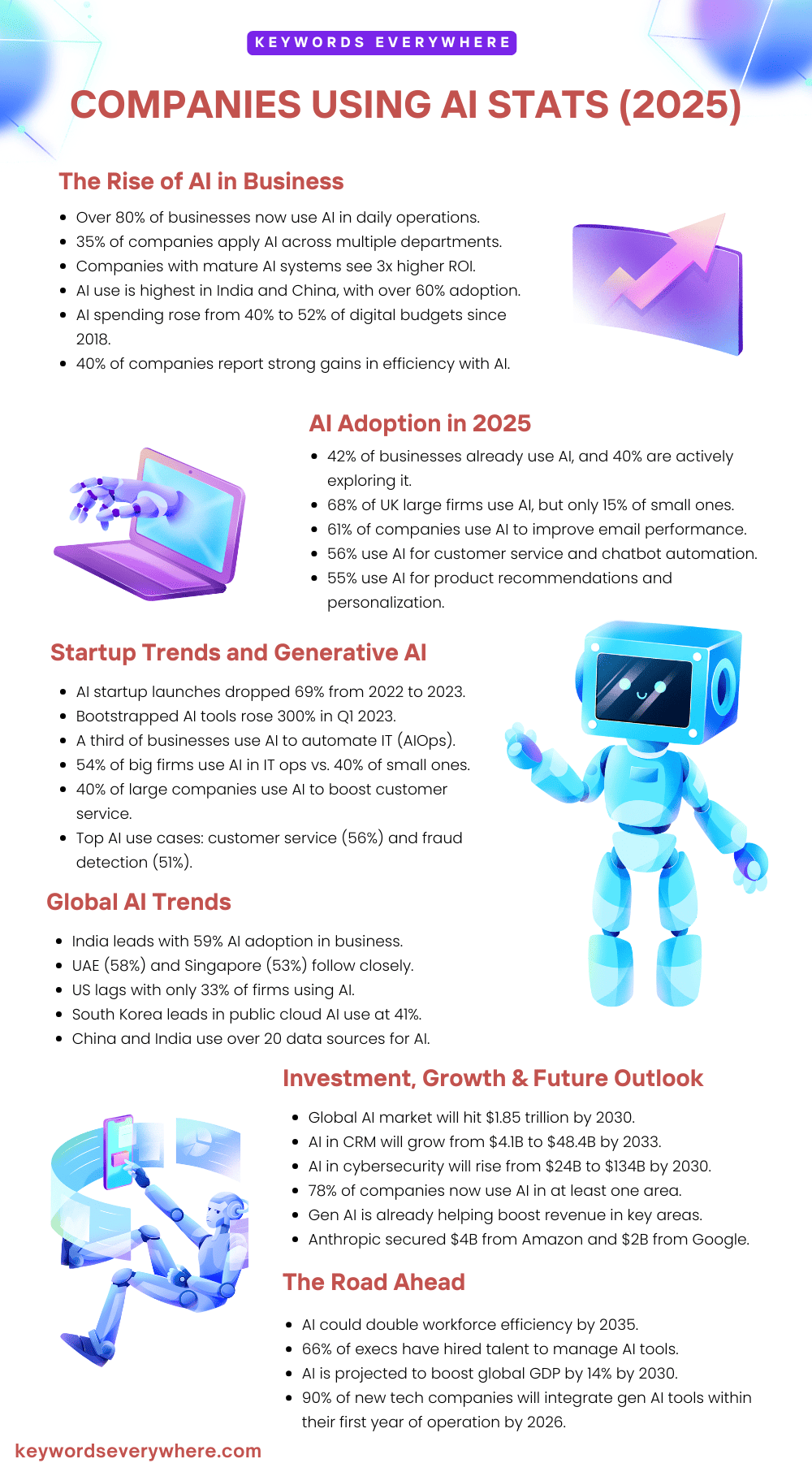
Top Companies Using AI Stats
AI isn’t just a buzzword anymore — it’s something you’ll find in almost every business conversation today.
Whether it’s helping teams work smarter, speeding up decisions, or reshaping customer service, companies are leaning into AI like never before.
These top companies using AI stats show just how far AI has come and why it’s now a must-have, not a maybe.
1. Over 80% of businesses are now using AI in some form, and many of them see it as a core part of how their organization works, showing how deeply AI is being built into everyday business operations.
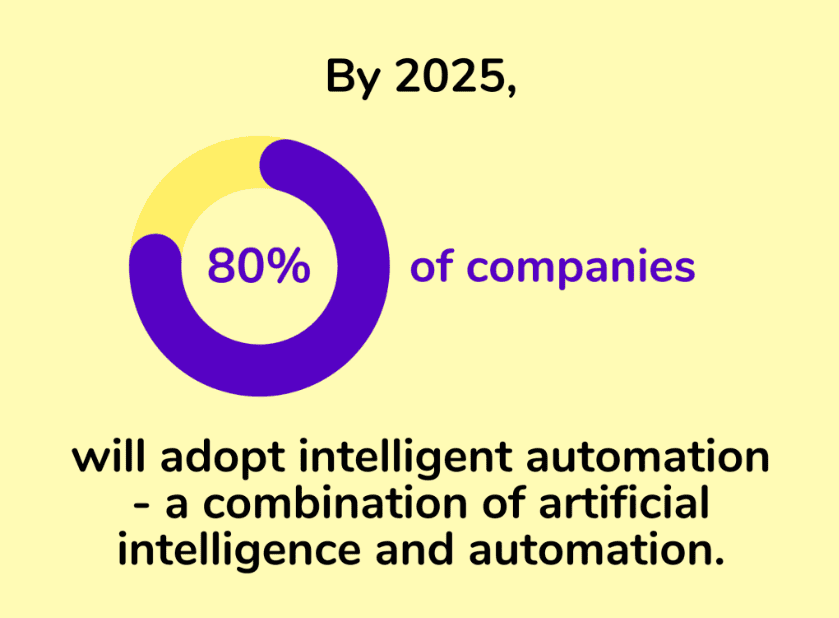
AI adoption by companies
2. 35% of these companies are using AI across multiple departments, not just in one area, which shows that AI is expanding its role within businesses and not just being used in isolated projects.
3. Around 80% of executives believe that automation through AI can be applied to almost any business decision, which means the number of companies using AI will only rise as leaders continue to trust its potential.
4. AI adoption is moving fastest in India and China, where around 60% of IT professionals say their companies are actively using AI in real business operations and not just testing it.

AI adoption rates around the world
5. This level of adoption stands out when compared to countries like South Korea (22%), the United States (25%), Australia (24%), and the United Kingdom (26%), where the numbers are much lower.
6. AI has become especially important in service operations, strategic planning, and corporate finance, and most industries report that about 20% of the work done in these areas now involves AI technology.
7. The industries that are benefiting the most from AI include telecom, risk management, and retail service operations, where AI is being used to improve efficiency with optimization rates of 38% and 31%, which are significantly higher than the average.
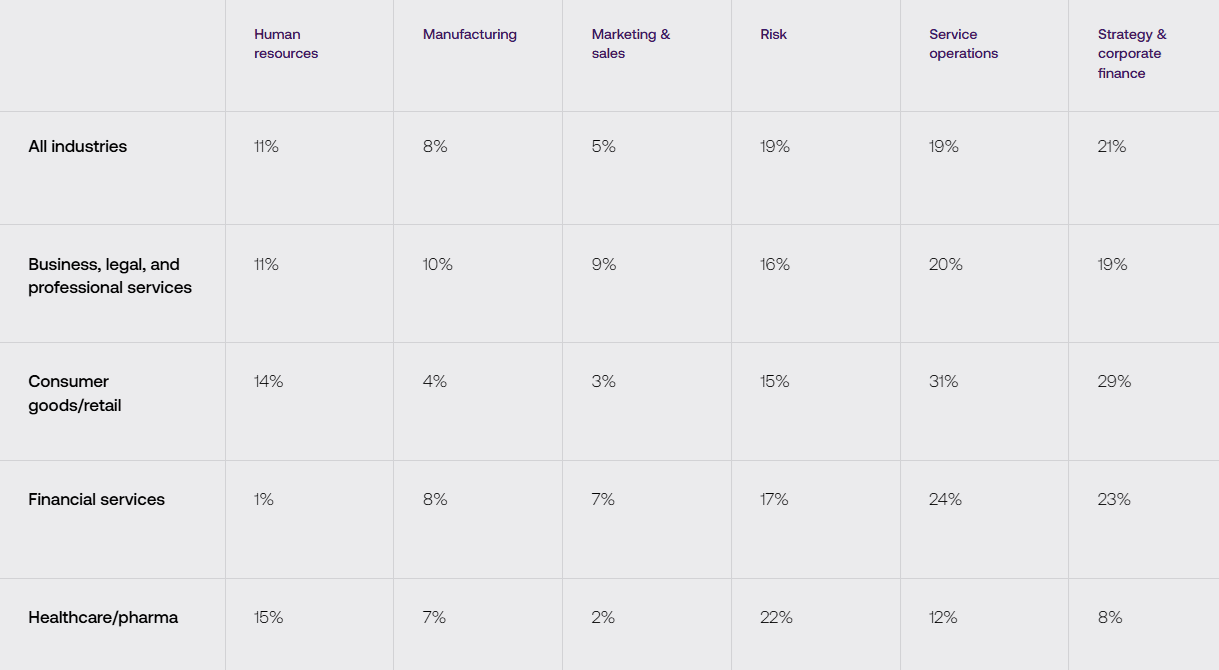
AI adoption rates by industry
8. Across organizations, the most commonly expected benefit from using generative AI continues to be improved efficiency and productivity, and 40% of companies say they’re already seeing these results either to a large or very large extent.
9. Companies that are highly mature in their use of AI—meaning they’ve deeply integrated it into their systems—tend to see three times higher returns on investment than those that are still just exploring or testing what AI can do.
10. According to a Deloitte survey, there are several major issues that could slow down the use of generative AI over the next two years, including:
- Real-world mistakes (35%)
- Not meeting expectations (34%)
- Lack of quality data (30%)
- Loss of trust due to bias or errors (29%)
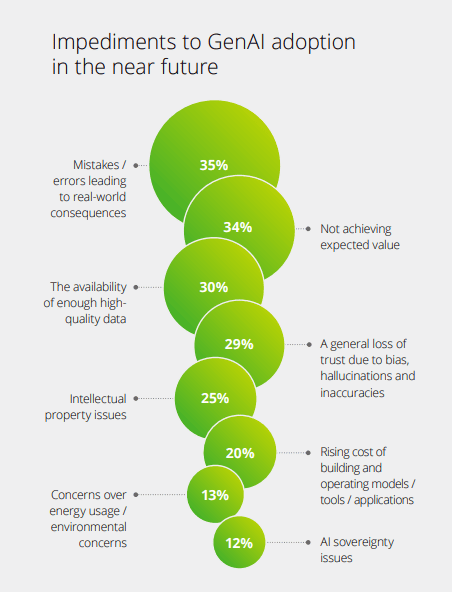
Barriers to Gen AI adoption in future
11. Alongside the rapid rise in AI usage, spending on AI has also grown. In 2018, only 40% of organizations that used AI were spending more than 5% of their digital budget on it, but by 2023, that number had jumped to 52%, showing that AI is becoming a top financial priority for many businesses.
How Many Companies Are Using AI in 2025?
Five years ago, AI felt like a tool only tech giants could afford, but that’s changed fast. Now, businesses of all sizes are finding real ways to use AI in their everyday work.
This section breaks down how many companies are using AI today and what that says about the growing trust in its power to save time, reduce costs, and spark new ideas.
12. Organizations are beginning to see AI and data as the main tools for transforming how they work, with around 50–60% of companies now using AI to improve different parts of their operations like forecasting demand more accurately, managing supply chains more efficiently, and making smarter product suggestions for customers.

AI usage and adoption by companies
13. 42% of companies have already started using AI in some way inside their business, and another 40% are actively exploring how they can start using it, which means that more than 82% of companies are either already using AI or seriously looking into it.
14. In the UK, AI adoption varies by company size—68% of large businesses use at least one AI technology. That number drops to 34% for medium-sized companies and 15% for small businesses, showing a big gap in AI use based on resources and scale.
15. AI is being used in many day-to-day business tasks:
- 61% of companies are using it to improve email performance,
- 56% are using it for customer service like chatbots or automated help,
- and 55% are using it to offer product recommendations and other personalized experiences to customers.
16. 48% of businesses rely on AI, machine learning, and data tools to keep their information accurate.
17. 46% of businesses use AI for internal communication needs, such as helping with company reports, strategic plans, and presentations.
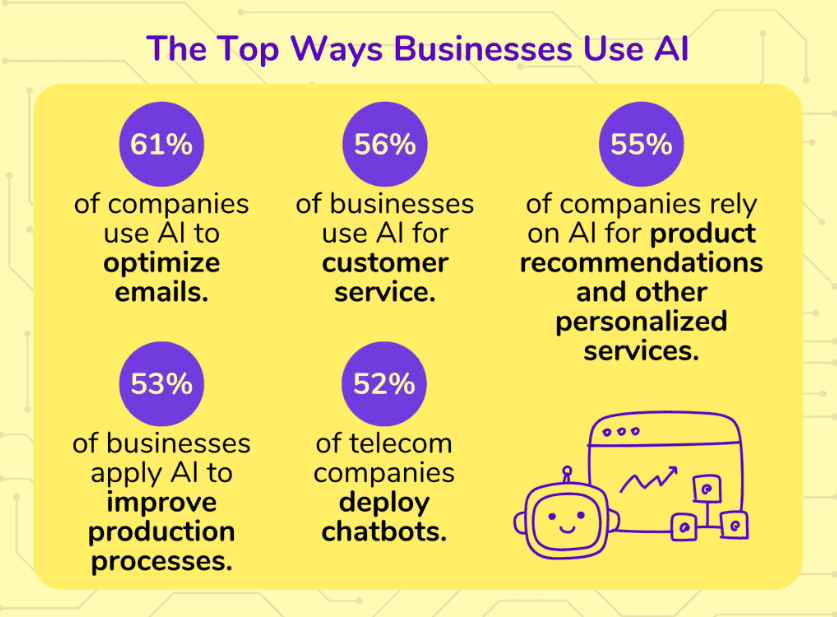
Top ways businesses use AI
18. AI is also being used to help with hiring and staffing—26% of businesses use it to source or recruit talent, 25% to handle skill shortages, and 24% for audience segmentation, which helps them target the right groups of customers more effectively.
19. The number of new AI startups launched saw a big drop in early 2023. In the first quarter of 2022, there were 688 new AI startups, but in Q1 2023, that number fell to just 269, which is a 69% decrease year over year.
20. Even though fewer large AI startups were launched, there was a big shift in how AI projects started. In Q1 2023, there was a 300% increase in small, bootstrapped AI tools, showing that more solo developers and small teams are building simple, focused AI products without outside funding.
AI In Workflows
It’s one thing to say a company “uses AI,” but what does that really mean?
These companies using AI stats take a closer look at how AI is showing up in real work — powering smarter marketing, automating routine tasks, handling customer chats, spotting risks before they happen, and so much more.
You’ll see where AI is making a real difference, not just in theory but in daily tasks.
21. According to IBM, about one-third of companies are already using AI to automate their IT processes, known as AIOps, which helps them keep application performance steady while using resources more efficiently.
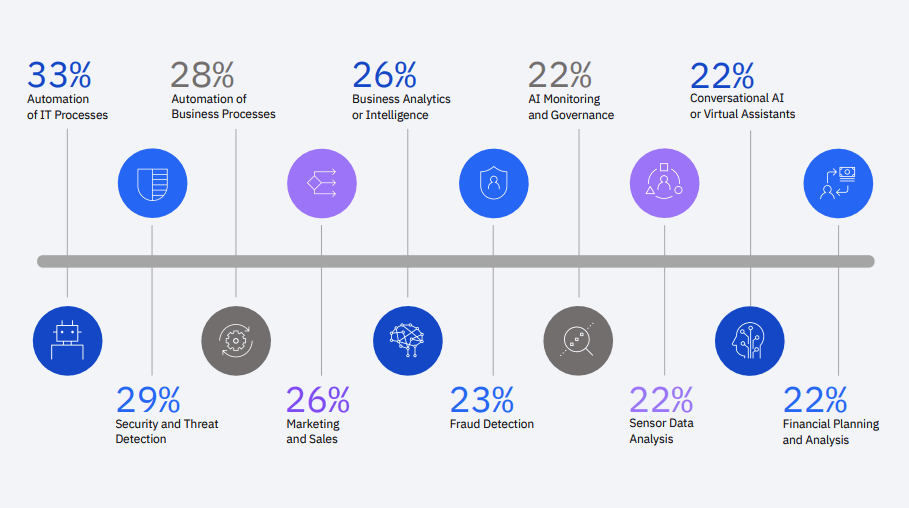
How organizations are using AI today
22. Around 40% of large companies are using AI to boost the productivity of customer service agents, personalize experiences for both customers and employees and make it easier for them to find information and solve common issues.
23. Most IT professionals at large companies (54%) are using AI to improve IT operations, compared to just 40% at smaller companies.

Reasons why organizations use automation software and tools
24. In the automotive industry, 50% of IT professionals say their company uses AI to create more personalized experiences for both customers and employees.
25. In the chemicals, oil, and gas sectors, as well as in the utility and environmental sectors, 40% of companies are using AI to improve personalization.
26. IT professionals at bigger companies are more likely to use natural language processing (NLP) tools for security (42%), customer care (39%), and business development (37%).
27. According to Forbes, the most common ways companies use AI are customer service (56%) and cybersecurity or fraud management (51%).

Top ways business owners use AI
28. Other popular uses include customer relationship management (46%), digital personal assistants (47%), inventory management (40%), and content production (35%).
29. Companies also use AI for product recommendations (33%), accounting (30%), supply chain operations (30%), recruiting and talent sourcing (26%), and audience segmentation (24%).
AI Regional Adoption Stats
AI adoption isn’t growing at the same pace everywhere, and that’s what makes it interesting. While some regions are racing ahead, others are just getting started.
These companies using AI stats look at how different countries and regions are embracing AI, what’s driving their progress, and how local challenges are shaping the global AI landscape.
30. As of 2024, India leads the world in business AI adoption, with 59% of companies having implemented AI.
31. The United Arab Emirates follows closely, with 58% of companies using AI, and Singapore comes next at 53%. The United States has one of the lowest adoption rates, with only 33% of companies using AI.
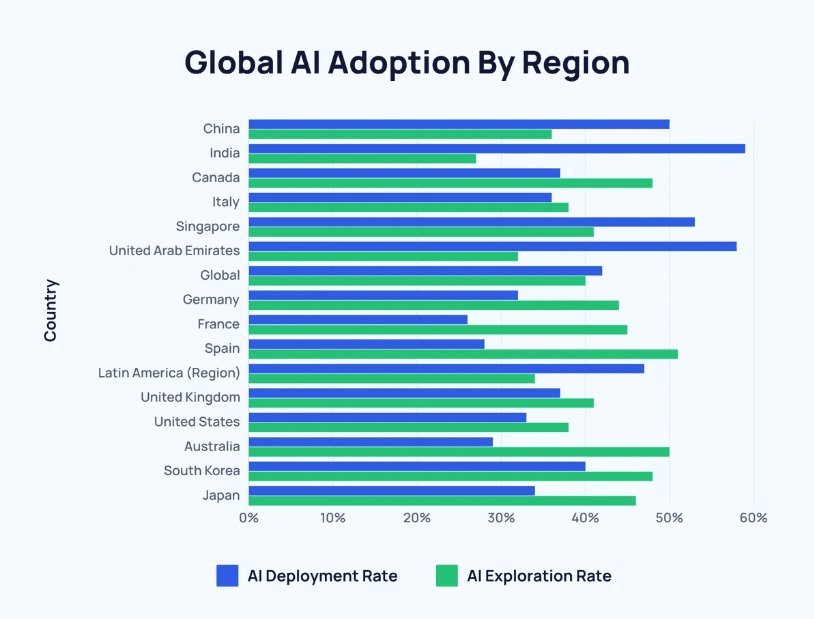
AI adoption rate by region
32. Across all countries, most IT professionals say their company uses more than 20 different data sources for AI, BI, and analytics, with China and India using the widest range of sources.
33. IT professionals in China, Germany, India, and Singapore report their companies use a mix of systems, like hybrid cloud or multi-cloud environments.
34. South Korean companies are more than twice as likely to use public cloud, with 41% doing so, compared to only 10–20% in other countries.
35. According to IBM, Chinese and Indian companies are ahead in AI use, with nearly 60% of IT professionals in both countries saying their organization already uses AI, much higher than in South Korea (22%), Australia (24%), US (25%), and the UK (26%).
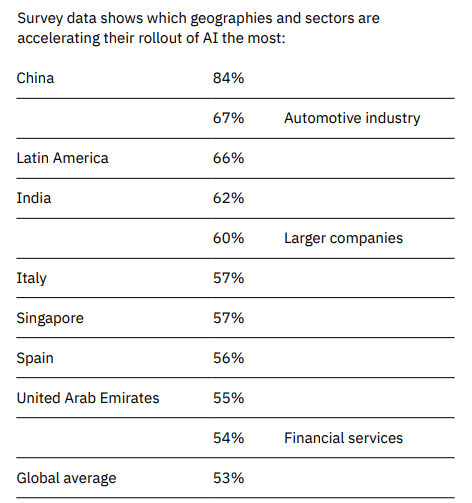
IBM survey data
36. IT professionals in China, India, and Singapore are more likely to say that 25% or more of their workforce needs access to company data to make decisions.
37. IT professionals in China, India, Singapore, and the UAE are more likely to report that their organizations are training employees to work with AI and automation tools.
38. The demand for trustworthy AI is not equal around the world. In India and Latin America, more than two-thirds of IT professionals strongly agree that consumers prefer companies with clear and ethical AI practices, while in France (33%), Germany (29%), and South Korea (21%), far fewer feel the same.

Percentage of trust and explainability most important to businesses
39. In most countries, IT professionals say their top step to ensure responsible AI is protecting data privacy. Professionals in China say they focus on monitoring AI systems across cloud and AI platforms, while in France, the focus is more on guarding against adversarial threats.
40. US companies are behind in using AI for environmental challenges. While 87% of them say they have ESG initiatives, 22% say that AI isn’t used at all for this, the highest percentage in the world.
AI Spending, Expansion & Future Plans
The money behind AI tells its own story — and it’s a big one.
From massive increases in AI budgets to skyrocketing market projections, businesses aren’t just testing AI anymore, they’re betting big on it.
These companies using AI stats dig into how much companies are investing, how fast the market is growing, and what that means for the next few years.
41. The AI market is expected to reach $1.85 trillion by 2030, growing at a 37.3% compound annual growth rate from 2024 to 2030.
42. Generative AI in the CRM market is expected to grow rapidly, from USD 4.1 billion in 2023 to USD 48.4 billion by 2033, with a CAGR of 28%.
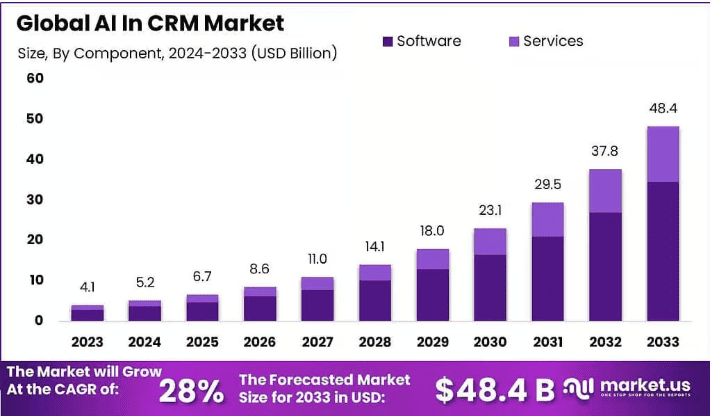
Global AI in CRM market
43. AI is not expected to replace security professionals but can be a strong support tool. The AI cybersecurity market is forecasted to grow from about $24 billion in 2023 to around $134 billion by 2030, bringing new advancements in data protection, threat detection, and user access control.
44. One of the biggest reasons AI is being adopted in global markets is the need to reduce costs and automate important business processes.
45. In a recent survey, 78% of respondents said their organizations use AI in at least one business function, which is up from 72% in early 2024 and 55% a year earlier.
46. The business area with the biggest jump in AI use in the past six months is IT, where usage rose from 27% to 36%.
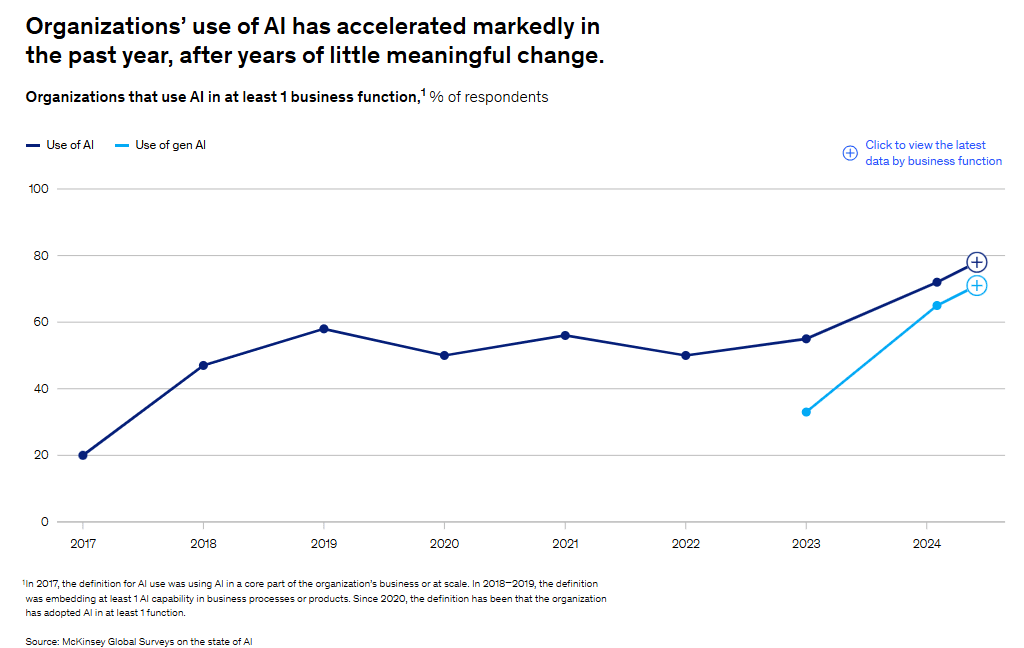
Graph indicating an increase in the use of AI
47. Use of generative AI (gen AI) has also increased since early 2024, with 71% of respondents saying their organization uses it in at least one business function, up from 65% earlier in the year.
48. Compared to early 2024, more people now say that gen AI use cases have helped increase revenue in the specific business units where they are being used.
49. However, over 80% of respondents say that their organization has not yet seen a noticeable impact on enterprise-level EBIT (earnings before interest and taxes) from using gen AI.
50. Anthropic drew major attention with two large investments: up to $4 billion from Amazon, making it one of the biggest AI investments of the year, and up to $2 billion from Google soon after.
51. Metropolis, a company that uses computer vision and AI for parking solutions, raised $1.1 billion in debt and equity, showing how AI is being used beyond tech and entering areas like urban infrastructure and logistics.

Big tech players are heavily investing in AI
The Road Ahead for AI in Business
We’re only scratching the surface of what AI can do. As companies get more comfortable with it, the next wave is already forming — smarter tools, deeper automation, and even AI that can help make big decisions.
The following companies using AI stats explore what’s coming next, from new trends to possible challenges, and how businesses are getting ready for a more AI-powered future.
52. AI can greatly boost business efficiency. As of 2024, it helps save an average of 2.5 hours per day per employee.
53. According to Accenture, AI in business operations is expected to double workforce efficiency and increase profitability by 38% on average by the year 2035.
54. According to Keywords Everywhere, the monthly search volume for “chatgpt for business” is 2,400, and the trend has been growing over the last two years, showing that more businesses are using AI assistants each year.
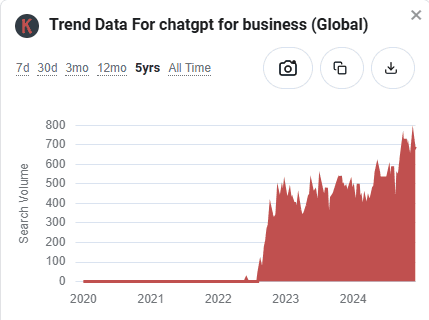
55. Many business owners are also using AI to save money—28% of business leaders have used it to reduce company costs.
56. Workers with AI skills are likely to be in high demand. 66% of company owners and executives have already hired someone to either implement new AI tools or improve current AI systems.
Conclusion
The AI market is growing at a remarkable pace and the number of companies using AI continues to rise along with it.
What once seemed like future technology is now essential to everyday business operations. As companies focus on cutting costs, improving efficiency, and staying competitive, investment in AI tools is only expected to increase.
From automating tasks to making smarter decisions, AI is proving to be a powerful force—and adoption will likely keep growing for years to come.


